The secrets of Oblivion's stunning special effects
Digital Domain's Eric Barba talks alien technologies and familiar faces in Joseph Kosinski's post-apocalyptic sci-fi film Oblivion.
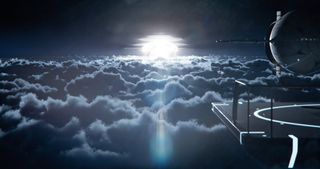
Visual effects have come a long way in 3D movies, a prime example being Joseph Kosinski's sci-fi hit Oblivion. Set on a post-apocalyptic Earth the film is packed full of spectacular vistas, stunning CG vehicles and explosions. Digital Domain and Pixomondo were main vendors for Oblivion, collectively contributing some 420 shots.
Over at Digital Domain, VFX supervisor Eric Barba was involved right from the beginning. "The intention had been to roll onto Oblivion straight after Tron Legacy," he reveals. "Then the original studio, Disney, decided to pass on it, so Joe and I did a few more commercials together in the meantime."
As a frequent collaborator with Joesph, Barba says he's very much attuned to the director's strong, architecturally informed visual style. "What's more, Joe's production designer Darren Gilford was somebody I went to school with, so the three of us work well together."
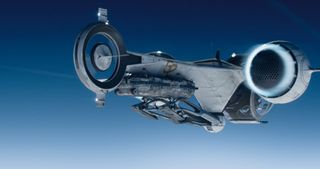
Icelandic illusion
The challenges with this project were, however, radically different to those they'd faced on Tron Legacy. "Last time we did about 85 per cent of the movie in the computer, and Joe really wanted to flip that around for this one, shooting as much in camera as possible," says Barba.
With Iceland acting as a futuristic, war-scarred American east coast, Digital Domain's tasks included adding the details necessary to sell the illusion. These included iconic landmarks such as the George Washington bridge along with huge tanker ships, all half-buried in sand.
"I think that juxtaposition of something known placed into a landscape that's totally unknown really makes it work," notes Barba. "It immediately lets the audience know that this story is rooted in a place that was once our world."
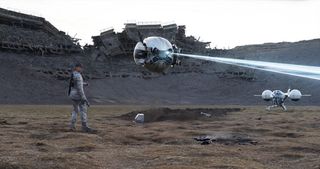
The studio was also responsible for creating the armed drones. "They had physically built versions on set, but just couldn't work with them – even moving them around for lighting reference proved difficult," says Barba.
"So while there are some shots where the physical models were used when stationary and in the background, for all other instances we replaced them. As they were built to such a high level we were able to take photos and CAD files and build them to a level that was quite easy to sell as believable."
As the drones are essentially huge chrome balls, on-set reference was essential to successful integration, though as Barba notes, their shiny exterior didn’t necessarily make for plain sailing.
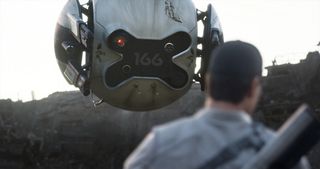
"With HDRs, the issue is always that you end up with around 100 crew members reflected in there, and furthermore with this shoot, the sun was always moving very rapidly and the guys would have around two minutes to get in there to shoot HDR reference, so a good amount of cleanup was required for the reflectivity," he explains.
"That said, Benjamin Button really pushed us to new heights, and we've been able to carry that forward and become incredibly efficient, so photorealism really isn't so difficult now."
A sense of scale
Another key piece of futuristic tech created by the studio is the Tet, a pyramid-shaped structure orbiting the Earth. "Joe wanted it to be sparse both inside and out, which we struggled with a little bit," says Eric.
"I looked at a Google Earth section to work out what a 30-mile diameter would look like, and realised that the corresponding on-screen real estate doesn't give that many pixels to work with. We really had to work to convey the right sense of scale."
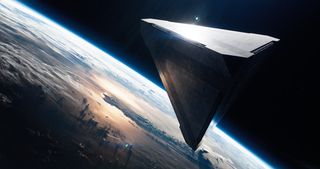
Another challenge arose because of a sequence in which Harper confronts another version of himself and the two engage in hand-to-hand combat. Eric says they rehearsed extensively with Cruise and the stunt team, to allow for the use of traditional techniques such as split-screens. But it was clear that the stuntman's head would need digitally replacing in a few shots.
"We couldn't put Tom and the stuntman in mocap suits, as they were already sweating to death in the temperatures out on location," says Barba. "In the end we went 'Benjamin Button-lite'. We took Tom down to Paul Debevec's department at ICT and performed full scans, obtaining enough data to do the replacements."
While internal scheduling issues at Digital Domain meant that production had to switch partway from Vancouver to Los Angeles, Eric says that overall post-production for Oblivion was a remarkably smooth process. "Some shows can be hell for the last three or four weeks, but because we’d started working with Joe pretty early on, we had a pretty soft landing."
Words: Mark Ramshaw
This article originally appeared in 3D World issue 177.

Thank you for reading 5 articles this month* Join now for unlimited access
Enjoy your first month for just £1 / $1 / €1
*Read 5 free articles per month without a subscription

Join now for unlimited access
Try first month for just £1 / $1 / €1
Get the Creative Bloq Newsletter
Daily design news, reviews, how-tos and more, as picked by the editors.
The Creative Bloq team is made up of a group of design fans, and has changed and evolved since Creative Bloq began back in 2012. The current website team consists of eight full-time members of staff: Editor Georgia Coggan, Deputy Editor Rosie Hilder, Ecommerce Editor Beren Neale, Senior News Editor Daniel Piper, Editor, Digital Art and 3D Ian Dean, Tech Reviews Editor Erlingur Einarsson and Ecommerce Writer Beth Nicholls and Staff Writer Natalie Fear, as well as a roster of freelancers from around the world. The 3D World and ImagineFX magazine teams also pitch in, ensuring that content from 3D World and ImagineFX is represented on Creative Bloq.
